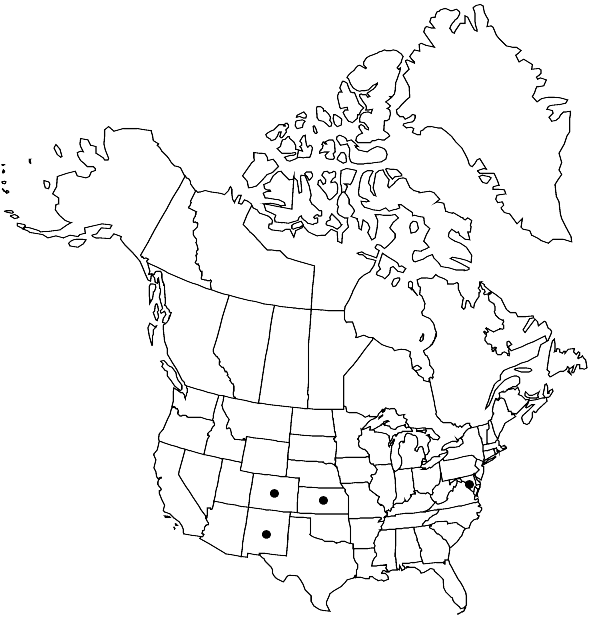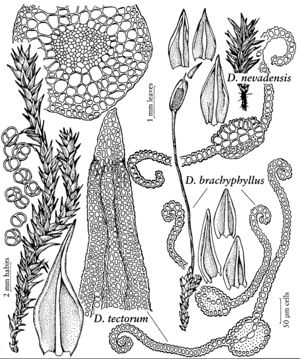Didymodon tectorum
J. Hattori Bot. Lab. 39: 516. 1975,.
Plants green to dark green, without a reddish cast. Stems to 2 cm, central strand present. Stem leaves appressed to weakly spreading when dry, spreading but stiff and not keeled when moist, monomorphic, deltoid to deltoid-lanceolate, grooved adaxially along the costa, especially near leaf apex, 1–1.5(–2) mm, base squared in shape, margins strongly recurved or revolute to near apex of leaf, entire, apex narrowly obtuse, not fragile, commonly ending in a mucro; costa short-excurrent as a several-celled blunt mucro, not strongly spurred, little widened toward apex, little tapering, sometimes rather thick and bulging adaxially, lacking a adaxial thin-walled pad of cells or this poorly developed, adaxial costal cells quadrate to short-rectangular, 4(-6) cells wide at mid leaf, guide cells in 1(–2) layers; basal laminal cells differentiated medially or across the leaf, walls mostly thin, quadrate to short-rectangular, not perforated; distal laminal cells 7–10 µm wide, 1:1, nearly smooth or papillae simple or 2-fid, 2–3 per lumen, lumens quadrate or rounded-quadrate, walls weakly convex on both sides of lamina, distal leaf margins 1-stratose or occasionally 2-stratose in patches. Specialized asexual reproduction by axillary, multicellular gemmae. Seta 0.8–1 cm. Capsule 1.5–2.5 mm; peristome teeth 32, linear, twisted 1/2 to once, to 1300 µm. Spores 11–12 µm. Distal laminal KOH reaction negative or weakly red.
Habitat: Limestone shales, riverside, dry shaded rocks, granite cliffs and ledges, north-facing bluff
Elevation: low to high elevations (100-2200 m)
Distribution

Colo., Kans., Md., N.Mex., Asia (China, Japan).
Discussion
Although Didymodon brachyphyllus may occasionally lack the usual dense reddish cast in nature or even with KOH, D. tectorum is always green in nature (though weakly red-brown proximally) (R. H. Zander and R. Ochyra 2001). Didymodon luridus Hornschuch of Europe is similar but does not have the squared leaf base, is evenly narrowed to the mucro, and has leaf cells that are smooth or nearly so. The lanceolate leaves of D. vinealis distinguish it from this species though small plants rarely may have gemmae. One collection (New Mexico: E. B. Bartram 99, US) is similar in its stout costa to European material of D. cordatus Juratska. The cells on the adaxial surface of the costa are elongate in some European plants of D. cordatus but quadrate in others in the same collection.
Selected References
None.
